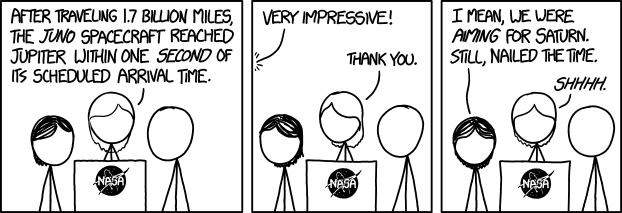1703: Juno
Explanation
| |
This explanation may be incomplete or incorrect: Created by a BOT - Please change this comment when editing this page. If you can address this issue, please edit the page! Thanks. |
Transcript
- [Blonde] After traveling 1.7 billion miles, the Juno spacecraft reached jupiter within one second of its scheduled arrival time.
- [Off] Very impressive!
- [Blonde] Thank you.
- [Dark haired] I mean, we were aiming for saturn. Still, nailed the time.
- [Blonde] Shhhh.
Discussion
According to http://www.space.com/18383-how-far-away-is-jupiter.html it is about 600 million miles to Jupiter, and according to http://www.space.com/18477-how-far-away-is-saturn.html it is about 1.7 billion miles to Saturn. So they went the distance to Saturn but ended up in Jupiter. They must have gone i pretty long circles to go 1.7 billion miles to get 600 million miles away. Aquaplanet (talk) 14:46, 6 July 2016 (UTC)
- That's 1.7 billion kilometers. They lost the Mars Climate Orbiter that way. .42 (talk) 15:38, 6 July 2016 (UTC)
- Actually, the space.com website does say Saturn is 1.7 billion miles away at its furthest, just as Jupiter is 600 million miles at its furthest. In either case, interplanetary travel isn't a matter of taking the shortest route. Yes, Juno went 1.7 billion miles to go to Jupiter (anywhere from 365 million to 600 million miles away, currently 370 million according to Google), because it was the easiest / most cost effective (in terms of fuel) way to get there. --Mr. I (talk) 15:47, 6 July 2016 (UTC)
- Jupiter is actually 872 million km away right now, which just happens to be roughly the current distance to Saturn if kilometers are confused with miles. .42 (talk) 16:18, 6 July 2016 (UTC)
- These interesting observations should be included in the explanation --Kynde (talk) 17:29, 6 July 2016 (UTC)
- Here is a cool animation showing the path that Juno took to get to Jupiter: https://66.media.tumblr.com/4e881a0340b323bcdfa3797001ca1c6c/tumblr_o9ua2xrMW11qiz5q7o1_540.gif mwburden (talk) 13:31, 7 July 2016 (UTC)
- These interesting observations should be included in the explanation --Kynde (talk) 17:29, 6 July 2016 (UTC)
- Jupiter is actually 872 million km away right now, which just happens to be roughly the current distance to Saturn if kilometers are confused with miles. .42 (talk) 16:18, 6 July 2016 (UTC)
Of course anyone who has bought a used car off Autotrader will know that how far away something is doesn't necessarily correlate particularly well to how far you have to go to get there 141.101.98.59 14:57, 6 July 2016 (UTC)
Several sources have reported that Juno arrived at its Jupiter orbit 1 second off schedule http://www.usatoday.com/story/tech/nation-now/2016/07/06/how-juno-arrived-jupiter-one-second-off-schedule/86745128/. --108.162.221.13 15:33, 6 July 2016 (UTC)
- I was going to come here to ask "Did they really make it within one second? And how do they decide when it is 'in orbit'?", but in that article is a quote "We hit our burn targets within one second" which makes sense - 'in orbit' starts when the engines turn off after the last course correction. 108.162.246.73 (talk) (please sign your comments with ~~~~)
- Blondie as a new character?
2nd time in short order "Blondie" has been the main character. See this Community portal proposal regarding new categories and please comment there for or against. --Kynde (talk) 19:53, 6 July 2016 (UTC)
- Who says what in the title text?
Given that Juno was connected to both Jupiter and Saturn, the point of the title text is a little obscure. However, it seems fairly clear to me that the first question ("The name wasn't a tip-off?") is supposed to come from the NASA team (i.e., "it didn't tip you off that we were aiming for Saturn?") and that the reply is supposed to come from the press. NASA named the probe. NASA decided where to send it. It makes no sense for the press to ask that first question, or for NASA to assume it was named after Juneau or guess that gravity assist "must be more efficient or something". Kynde appears to disagree with me, however, so perhaps some other people could weigh in and give their views. Garik (talk) 16:51, 6 July 2016 (UTC)
- Yes I still disagree. To me it seems like a continuation of the conference and it is now the press to speak. And given that I knew Juno to be related to Jupiter but not that she was the daughter of Saturn (and given the reason for the naming in the real world) I would not say that the name in any way would lead anyone to take it as a hint for going to Saturn. But great to discuss it. For sure it was NASA who made the mistake not the press. --Kynde (talk) 17:24, 6 July 2016 (UTC)
- Now we have both deleted each others edits. So to prevent an edit war I have inserted both versions for now. --Kynde (talk) 17:53, 6 July 2016 (UTC)
- As Homer Simpson would say: "Kids, you're both right!". However my first impromptu interpretation when I read the comic was the first. But after thinking about it, I tend more to the second (with Megan saying the first sentence) and like to present a fourth alternative: Both statements are from the press (different persons, ofc). Elektrizikekswerk (talk) 08:18, 7 July 2016 (UTC)
Juno: "You Know" - 141.101.104.143 16:46, 7 July 2016 (UTC)
Juno is also a rather large asteroid (which I suppose is closer to Jupiter than to Saturn, though might not necessarily be closer to Jupiter than to Alaska). Should this fact be mentioned in the explanation? 172.68.11.43 08:29, 8 July 2016 (UTC)

